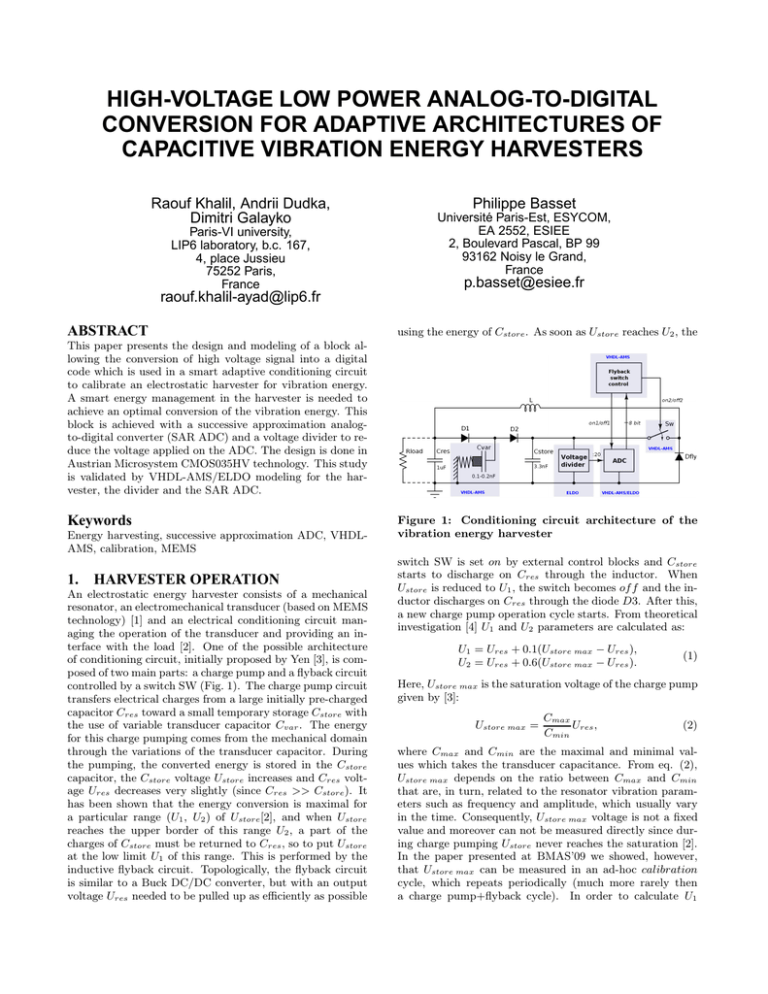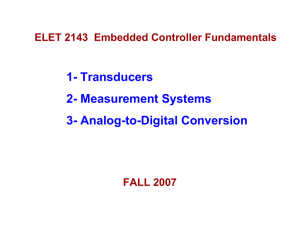high-voltage low power analog-to-digital conversion for
advertisement

HIGH-VOLTAGE LOW POWER ANALOG-TO-DIGITAL CONVERSION FOR ADAPTIVE ARCHITECTURES OF CAPACITIVE VIBRATION ENERGY HARVESTERS Philippe Basset Raouf Khalil, Andrii Dudka, Dimitri Galayko Université Paris-Est, ESYCOM, EA 2552, ESIEE 2, Boulevard Pascal, BP 99 93162 Noisy le Grand, France Paris-VI university, LIP6 laboratory, b.c. 167, 4, place Jussieu 75252 Paris, France p.basset@esiee.fr raouf.khalil-ayad@lip6.fr ABSTRACT This paper presents the design and modeling of a block allowing the conversion of high voltage signal into a digital code which is used in a smart adaptive conditioning circuit to calibrate an electrostatic harvester for vibration energy. A smart energy management in the harvester is needed to achieve an optimal conversion of the vibration energy. This block is achieved with a successive approximation analogto-digital converter (SAR ADC) and a voltage divider to reduce the voltage applied on the ADC. The design is done in Austrian Microsystem CMOS035HV technology. This study is validated by VHDL-AMS/ELDO modeling for the harvester, the divider and the SAR ADC. Keywords Energy harvesting, successive approximation ADC, VHDLAMS, calibration, MEMS 1. HARVESTER OPERATION An electrostatic energy harvester consists of a mechanical resonator, an electromechanical transducer (based on MEMS technology) [1] and an electrical conditioning circuit managing the operation of the transducer and providing an interface with the load [2]. One of the possible architecture of conditioning circuit, initially proposed by Yen [3], is composed of two main parts: a charge pump and a flyback circuit controlled by a switch SW (Fig. 1). The charge pump circuit transfers electrical charges from a large initially pre-charged capacitor Cres toward a small temporary storage Cstore with the use of variable transducer capacitor Cvar . The energy for this charge pumping comes from the mechanical domain through the variations of the transducer capacitor. During the pumping, the converted energy is stored in the Cstore capacitor, the Cstore voltage Ustore increases and Cres voltage Ures decreases very slightly (since Cres >> Cstore ). It has been shown that the energy conversion is maximal for a particular range (U1 , U2 ) of Ustore [2], and when Ustore reaches the upper border of this range U2 , a part of the charges of Cstore must be returned to Cres , so to put Ustore at the low limit U1 of this range. This is performed by the inductive flyback circuit. Topologically, the flyback circuit is similar to a Buck DC/DC converter, but with an output voltage Ures needed to be pulled up as efficiently as possible using the energy of Cstore . As soon as Ustore reaches U2 , the L D1 Rload Cres Sw D2 Cvar Voltage divider ADC Dfly Figure 1: Conditioning circuit architecture of the vibration energy harvester switch SW is set on by external control blocks and Cstore starts to discharge on Cres through the inductor. When Ustore is reduced to U1 , the switch becomes of f and the inductor discharges on Cres through the diode D3. After this, a new charge pump operation cycle starts. From theoretical investigation [4] U1 and U2 parameters are calculated as: U1 = Ures + 0.1(Ustore max − Ures ), U2 = Ures + 0.6(Ustore max − Ures ). (1) Here, Ustore max is the saturation voltage of the charge pump given by [3]: Ustore max = Cmax Ures , Cmin (2) where Cmax and Cmin are the maximal and minimal values which takes the transducer capacitance. From eq. (2), Ustore max depends on the ratio between Cmax and Cmin that are, in turn, related to the resonator vibration parameters such as frequency and amplitude, which usually vary in the time. Consequently, Ustore max voltage is not a fixed value and moreover can not be measured directly since during charge pumping Ustore never reaches the saturation [2]. In the paper presented at BMAS’09 we showed, however, that Ustore max can be measured in an ad-hoc calibration cycle, which repeats periodically (much more rarely then a charge pump+flyback cycle). In order to calculate U1 and U2 during the system calibration, we need to measure Ustore max and Ures . Consequently, to interface analog voltages with the digital electric circuit we need to use an analog-to-digital converter. Vibration energy harvesters provide low values of powers (tens microwatts), hence, the conditioning electronics, including ADC, should consume as few as possible. In this work, we demonstrate how the calibration cycle is done using a low power consumption 8-bit successive approximation ADC which consists of a comparator, Digital to Analog converter (DAC) and a Successive Approximation Register (SAR). 2. Ures value is explained by the accumulation of the energy of the system (i.e., a normal harvester operation). As we see, Ures is measured only once during the calibration cycle. In the normal operation mode between calibration cycles ADC is deactivated by the signal of f1 . The measured Ustore max value is reset to 0 and the equivalent Ures is saved until the next calibration cycle. CALIBRATION USING SUCCESSIVE APPROXIMATION ADC The calibration cycle starts with putting U1 to a very low value (zero), so that Cstore voltage becomes equal to Cres voltage. During 20 ms Ustore remains at the Ures value, which gives to the ADC enough time to measure it. After that, the flyback switch control orders the charge pumping to start, and Ustore starts to increase, up to the saturation. During this charge pumping, the voltage Ustore is measured with 3.6 ms sampling step. The goal of this measurement is to detect the Ustore max value. This is done as described in the section 1; the digital values corresponding to the neighboring samples of Ustore are compared, and when there are 2 consecutive steps have the same value, their value is considered as measured Ustore max . At the end of the calibration cycle the flyback switch control block turns of f the ADC and U1 as well as U2 are calculated. Then, the normal mode (periodic charge pump+flyback cycles) starts till the next calibration cycle as it is shown in the Fig. 2. 25 volt(v) 20 Saturation Ustore Ustore measured 15 10 5 0 6.2 Calibration Cycle Ures Normal Cycle Figure 3: Simulation results of harvester operation using the SAR ADC model 3. CONCLUSIONS In this paper, we presented the architecture design of the electrostatic vibration energy harvester with a successive approximation ADC. The use of such ADC in energy harvester application is suitable for a low power consumption. Simulation results of the harvester with the use of 8-bit SAR ADC demonstrate a good matching between Ustore and the measured from ADC Ustore mes during the calibration cycle. The estimated power consumption of the ADC is around 1.25µW for one step conversion. The comparator is the dominating block in power consumption of ADC with the used sampling frequency and 8-bit resolution, whereas the DAC has much less contribution. 4. ACKNOWLEDGEMENTS 6.25 6.3 6.35 6.4 time(s) 6.45 6.5 6.55 Figure 2: Calibration cycle of the harvester 2.1 Modeling Results In order to validate our study we created and simulated models of the divider and of the successive approximation ADC and connected them to the conditioning circuit model as it is shown in the Fig. 1. In this paper, we present simulation results which demonstrate the harvester operation with ADC during almost 11 seconds. Here, calibration cycles repeat every 900ms, such a low interval is chosen in order to reduce the modeling time, in reality the calibration phase should be less frequent (tens of seconds) to reduce the power consumed. In the top part of the Fig. 3, Ustore is plotted together with the measured Ustore voltage. We can see that during the calibration cycle there is a good matching between them because of the good resolution of the ADC. In the bottom part of the Fig. 3, the real Ures is plotted with the measured Ures voltage. The increase in the real This work is funded by the French National Research Agency (ANR) through the project ANR/ARPEGE 08-SEGI-019. 5. REFERENCES [1] P. Basset, D. Galayko, A. M. Paracha, F. Marty, A. Dudka, and T. Bourouina. A batch-fabricated and electret-free silicon electrostatic vibration energy harvester. Journal of Micromechanics and Microengineering, 2009. [2] Andrii Dudka, Dimitri Galayko, and Philippe Basset. Vhdl-ams modeling of adaptive electrostatic harvester of vibration energy with dual-output dc-dc converter. In IEEE International Behavioral Modeling and Simulation Conference (BMAS 2009). [3] B. C. Yen and J. H. Lang. A variable-capacitance vibration-to-electric energy harvester. IEEE TCAS, 53(2):288–295, february 2006. [4] D. Galayko and P. Basset. Mechanical/electrical power-aware impedance matching for design of capacitive vibration energy harvester. In PowerMEMS2008 workshop, Sendai, 2008.

